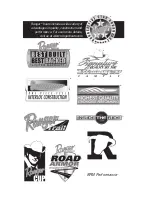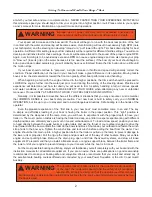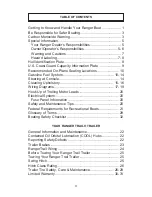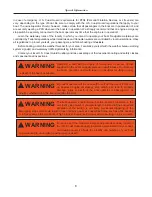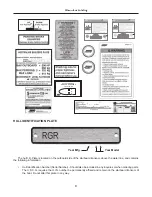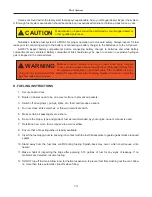
1
GETTING TO KNOW AND HANDLE YOUR RANGER BOAT . . .
Your Ranger dealer should see that you have selected the proper horsepower engine for the rating range of
the boat model you have chosen. The proper engine mounting height has been selected for optimum performance
and the correct propeller has been chosen.
Since most boats spend more time on the trailer than in the water, a RangerTrail® trailer can extend the useful
life of your new boat. The load MUST be evenly distributed on the properly fitting “bunks” or “pads” of the trailer.
The boat should not rest on the loading rollers, but should properly cradle on the bunks.
Always park your rig so that the trailer tongue is higher than the stern of the boat, so that any water can drain
from the hull when the drain plug is removed. All livewell valves should be placed in the “empty” position to properly
drain your livewell plumbing.
A properly fitted boat cover will protect your investment from the damaging effects of the ultraviolet rays of
sunlight, as well as from road film, rain and dirt abrasion while trailering. The cover also protects your accessory
equipment and fishing tackle from “prying eyes” and helps to guard against pilferage.
Familiarize yourself with the instruments and indicators used with all installed equipment. Factory equipment
manuals are included to assist you to properly operate your trolling motor; depth finders; engine tachometer;
speedometer; and any additional accessories that you have installed. Naturally this Ranger manual is only complete
when you have completely studied your engine operating manual and are familiar with engine operation.
Now you are ready for a ride in your new boat! This will be an exciting, fun experience if you exercise the proper
caution and observe all safety rules and regulations.
Before launching your boat… stop on the ramp short of the water. Stop your vehicle’s engine and set the
parking brake. At the rear of the boat, install your transom drain plug and remove the trailering tie-downs, trailering
arms, motor supports and/or support brackets. Slowly back the boat and trailer into the water and unhook the winch
strap hook. When in the driver’s seat, put on and secure your life vest and attach the engine emergency stop switch
lanyard to your person. Start engine and back your boat off the trailer. You should experience no problem if the
water is adequately deep for proper launching.
While you are easing along within the “No Wake” zone you should trim your engine all the way down to its
lowest position (in). Turn the steering right and left to insure that there is no undue slack and inspect the steering
system. Look for any loose connections at the engine and beneath the driver’s console (see pp. 24-25). Inspection
of this crucial linkage system can be visually made at home or at the lake, but should be done at regular intervals.
Before applying power and “opening it up”, insure that all passengers are properly seated and are wearing an
approved Personal Flotation Device (PFD or Life vest). Check to see that there are no obstructions in your path.
We recommend that the front pedestal seat be removed from the front deck base and positioned in the special base
provided in the front floor of the boat. If your boat has non-adjustable pedestals, remove the extension pipe from the
seat base and install the seat base directly into the front deck receptacle. If your boat has an optional deck extension
and power pedestals, remove the lid in the deck extension and secure the pedestal in the receptacle provided in
the floor. If the optional deck extension does not have a removable lid, store your seat securely in the floor of the
boat. This will provide for an unobstructed view while driving. The power pedestal should be pushed down into the
lowest position. Should there be no base provided in the floor, the seat should be removed and securely placed in
the floor of the boat.
When you have cleared the “No Wake” zone it is time to accelerate and get your new boat “on plane”. Before
applying power, insure that all passengers are properly and securely seated in appropriate locations. Move the
throttle lever into the full open position (full forward). The bow of the boat will rise into the air for a moment… this is
normal operation when a boat is “coming out of the hole” and is no cause for alarm. The bow will quickly come back
down into a level running position. When the boat begins to accelerate rapidly, the throttle should be pulled back to
obtain a comfortable running speed. Always increase your speed a little at a time until you are running at a speed
Getting To Know and Handle Your Ranger
®
Boat
Failure to store/park your rig with the bow elevated could allow rain water to
accumulate in the storage boxes.
NOTICE
Summary of Contents for RT Series
Page 20: ...18...


